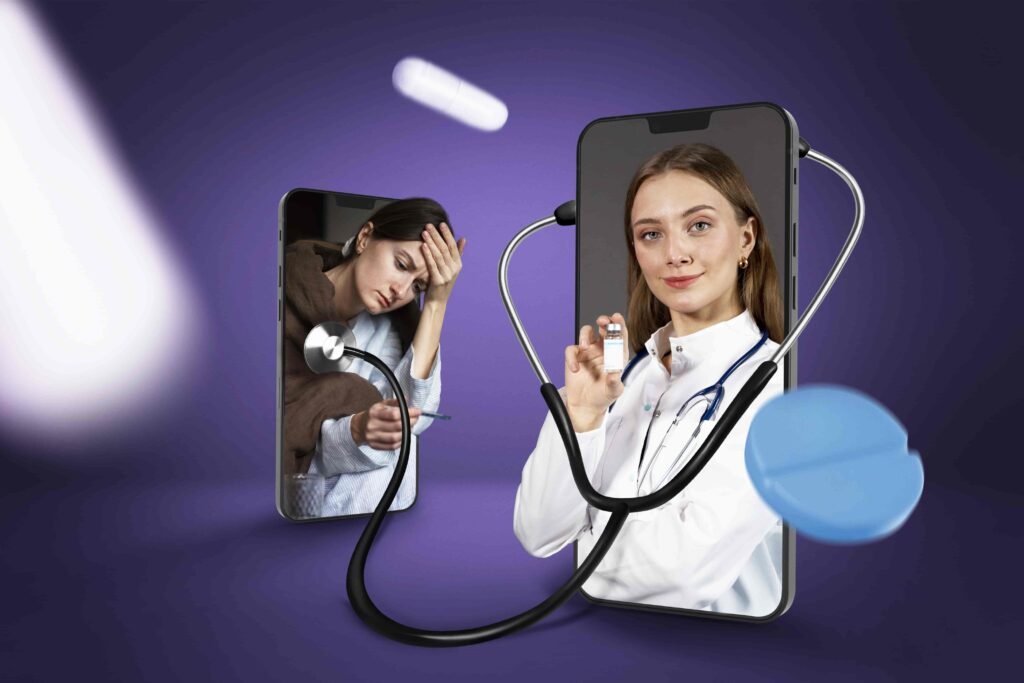In this era, we rely on technology more than before. The debate between telehealth and in-person counseling has gained significant momentum, particularly in the realm of mental health.
Now as people are more aware of mental health and related issues. They have started seeking support for their emotional and psychological well-being. Telehealth offers convenience and accessibility, breaking down geographical barriers and allowing for flexible scheduling. In contrast, traditional in-person counseling provides a tangible, face-to-face connection that many find crucial for fostering trust and empathy. understanding the benefits and challenges of each approach becomes essential.
In this blog, we will explore the nuances of both modalities, helping you determine which option might be the best fit for your mental health needs.
Telehealth Vs In-Person Counseling
Telehealth Counseling
The provision of healthcare services—including mental health counseling—through digital platforms is referred to as telehealth. Video chats, phone consultations, or even text messaging may be used for this. Numerous people find telehealth to be a dependable alternative due to its accessibility and ease.
Pros and Cons of Telehealth Counseling
Pros
Accessibility: A primary benefit of telehealth is its enhanced accessibility. Individuals in remote or underserved regions can get competent mental health providers who may otherwise be inaccessible.
Convenience: Clients can participate in sessions from the comfort of their homes. Arranging meetings is often more straightforward, therefore minimizing travel time and associated costs.
Flexibility: Telehealth provides more flexibility in appointment scheduling, accommodating individuals with demanding lives, and facilitating the maintenance of regular treatment sessions.
Comfort: For many individuals, the familiarity of their surroundings may facilitate openness in discussing personal matters, perhaps resulting in more successful treatment.
Mitigated Stigma: Online therapy helps alleviate the stigma linked to pursuing mental health treatment. Individuals can have less judgment while participating in treatment from the comfort of their own homes.
Cons
Technological Barriers: Limited access to essential technologies or a dependable internet connection might result in inequities in treatment.
Restricted Non-Verbal Indicators: Face-to-face contacts facilitate the observation of body language and other non-verbal signals, which are essential for comprehending a client’s emotional condition.
Absence of Personal Connection: Certain persons might struggle to establish a therapeutic alliance with their counselor via a screen, experiencing a disconnection that might hinder development.
Privacy Issues: Participating in treatment at home can elicit worries over confidentiality, especially if clients occupy shared places with those who can overhear their discussions.
Emergency Situations: In instances of severe mental health emergencies, rapid in-person help can be required, which telemedicine cannot provide.
In-Person Counseling
A therapist and a client engage in face-to-face conversations during in-person therapy. This age-old approach has long been the norm for mental health treatment because it offers a personalized touch that many people find consoling. Usually, therapy sessions take place at the therapist’s office, which provides a focused space free from interruptions.
Pros and Cons of In-Person Counseling
Pros
Personal Connection: Numerous individuals believe that in-person contacts develop a stronger therapeutic connection, which is essential for successful therapy.
Thorough Understanding: Therapists can accurately evaluate clients’ emotional conditions via non-verbal signals, enabling successful responses.
Immediate Assistance: In-person sessions provide prompt involvement, providing clients with essential on-site help.
Participation in Activities: Specific treatment modalities, such as art therapy or experiential exercises, can be more successfully administered in person.
Environment: The structured environment provides a feeling of order and regularity that some clients find beneficial in their therapeutic journey.
Cons
Accessibility Challenges: Individuals residing in distant locations or with restricted mobility might find it difficult to attend in-person treatment sessions.
Time Investment: Commuting to appointments can be time-consuming results in missed sessions, and impact improvement.
Expenses: In-person treatment sometimes incurs higher costs, such as transportation, which discourage people from continuing therapy sessions.
Scheduling Challenges: Identifying appropriate times for both the client and the therapist might be more complex than in telemedicine environments.
Stigma: Attending a therapist’s office may elicit sentiments of stigma in some people, and discourage them from seeking mental health support.
Telehealth or In-Person Counseling?
1. Individual Preferences
The comfort levels of individuals significantly influence the decision-making process. Some individuals feel at ease in the close confines of an office, whilst others may find more comfort addressing their concerns from home. Comprehending individual preferences is essential for identifying the optimal solution.
2. Characteristics of the Issues
The kind and intensity of mental health disorders might also affect the decision between telehealth and face-to-face therapy. Individuals experiencing intense mental health disorders can find in-person sessions more helpful, whereas those in pursuit of general advice or coping mechanisms could find telehealth to be comparably useful.
3. Treatment Methods
Certain treatment techniques can be more suited to one format than another. Therapies necessitating contact or physical presence, such as certain modalities of cognitive-behavioral therapy (CBT), may exhibit greater efficacy when conducted in person. Conversely, supportive therapy or psychoeducation may be effectively administered via telehealth
4. Provider Availability
The presence of skilled mental health specialists greatly influences the decision-making process. In regions with many telehealth choices, patients can have access to a broader selection of experts, increasing the probability of finding an appropriate match.
5. Insurance Coverage
Insurance plans often specify the categories of mental health therapies that are covered. Certain plans provide superior coverage for one format compared to another, which can be a determining factor for experiencing mental health issues.
The Future of Mental Health Care
As technology advances, the mental healthcare sector will likely increasingly use telehealth alongside conventional approaches. Hybrid models that include both modes of therapy are gaining prominence, enabling clients to choose their preferred therapeutic mode according to their individual requirements at various periods.
Some clients will first engage in in-person sessions to build trust with their therapist and then shift to telehealth for follow-up consultations. This adaptability provides an optimal balance, accommodating individual preferences while guaranteeing continuous assistance.
Conclusion
To sum up, the debate of telehealth and in-person therapy lacks a universal solution. Each technique has unique benefits and challenges, with the optimal selection contingent upon personal circumstances, preferences, and mental health requirements. By understanding both methodologies, individuals can make educated choices that improve their mental health care experience.
Regardless of the medium, the bond between client and therapist is founded on trust, comprehension, and a mutual dedication to personal development and recovery.







More Stories
Mushroom Hot Chocolate & Bars Benefits
Fast Kamagra Tablets Next Day Delivery UK
Where to Get the Beard Trim in Mississauga